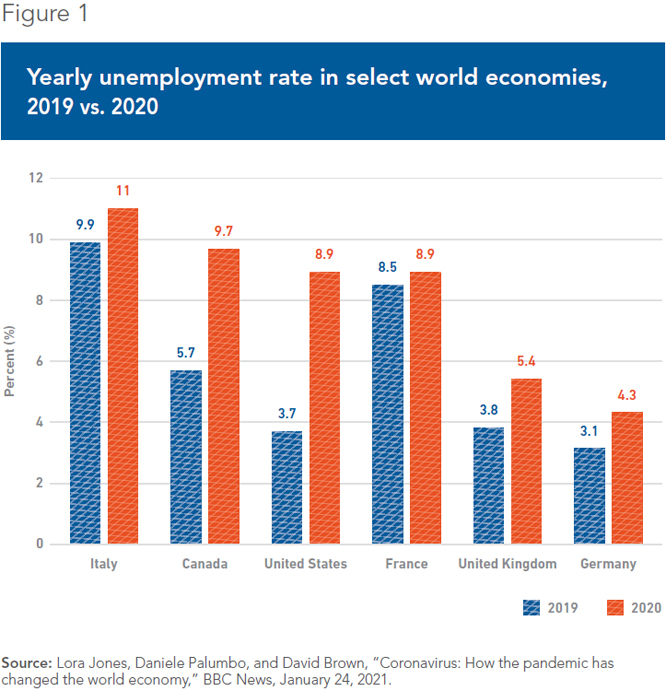Entrepreneurs Stepped Up in Response to COVID-19

Viewpoint on how numerous businesses came through for us when we needed them most
For over a year now, the spotlight has been on governments and the actions they have taken in the context of the pandemic, sometimes obscuring the great contribution of entrepreneurs in maintaining a certain quality of life for Canadians in these difficult times. This publication lifts the veil on the efforts made by entrepreneurs to reinvent themselves, pick up the pace, and help us meet this challenge.
 Related Content
Related Content
 |
 |
 |
| Entrepreneurs are pandemic’s unsung heroes (Montreal Gazette, March 11, 2021)
L’effort de guerre des entrepreneurs (Le Journal de Montréal, March 11, 2021) MEI calls entrepreneurs the ‘unsung heroes’ of the past year (Canada’s Podcast, March 11, 2021) |
Interview with Krystle Wittevrongel (CTV News Montreal at Noon, CFCF-TV, March 22, 2021) |
This Viewpoint was prepared by Krystle Wittevrongel, Public Policy Analyst at the MEI, in collaboration with Miguel Ouellette, Director of Operations and Economist at the MEI. The MEI’s Health Policy Series aims to examine the extent to which freedom of choice and entrepreneurship lead to improvements in the quality and efficiency of health care services for all patients.
While wreaking havoc on lives and livelihoods, the pandemic has required businesses to not only adapt quickly, but also to make short-term decisions with uncertain implications for the long term. Although global supply chains and financial markets have been significantly disrupted, when the government of Canada called on manufacturers to help in the battle against COVID-19, many businesses mobilized quickly.(1) Aside from the obvious and tremendously important worldwide effort by pharmaceutical companies to rapidly develop vaccines to fight the virus directly, here are a few more down-to-earth examples of how entrepreneurs came through when we needed them most, providing help and comfort in these unprecedented times.
Apparel Companies Kept Us Protected
In the early stages of the pandemic, the World Health Organization warned of personal protective equipment (PPE) shortages leaving doctors, nurses, and other frontline workers “dangerously ill-equipped” to care for COVID-19 patients.(2) To make matters worse, rising demand, panic buying, hoarding, and misuse were compounded by the federal government’s lack of preparedness to maintain and distribute domestic inventories.(3)
Harnessing its expertise in making helmet visors, hockey apparel company Bauer redirected operations in its Quebec facilities to make medical face shields for health care workers.(4) Charging just enough to break even, any profits accrued were earmarked for charity, with design specifications published online, entirely free of charge, to encourage other companies to follow suit. Nike and New Balance similarly repurposed their facilities to produce PPE,(5) and Canada Goose used manufacturing facilities in Toronto and Winnipeg to produce scrubs and patient gowns.(6)
Delivery Companies Saved Christmas
Facing store closures and panic-buying that emptied shelves quicker than they could be restocked, Amazon initially prioritized essential household items and those related to COVID-19 such as hand sanitizer, face masks, and disinfectants.(7) Amid widespread unemployment and economic turmoil, the company also hired more than 175,000 new warehouse and delivery workers to fulfill demand for essential household orders between March and mid-April 2020.(8) Amazon also spent billions on internal testing, PPE for workers, enhanced sanitation in its facilities, and the like.(9)
E-commerce spending in the third quarter of 2020 was up 37% over the same period in 2019, and retailers and shipping companies prepared for the holiday crunch by hiring widely. FedEx hired 70,000 new workers, UPS hired 139,000, and Amazon hired a further 100,000 seasonal workers.(10)
Technology Kept Us Connected
Pandemic-related lockdowns have reshaped the way businesses conduct their work. In the last week of March 2020, nearly 40% of Canadians were telecommuting.(11) Combined with the closure of schools and the use of virtual learning options, demand for communications technologies like Google Meet, Microsoft Teams, and Zoom has skyrocketed.
For example, in November 2019, Microsoft Teams had 20 million users. This more than doubled to 44 million by March 2020, and increased again to 75 million by April.(12) Research shows that the use of such communications technologies promoted the perception of social support, which mitigated some of the harmful psychological impacts of the lockdown.(13) Moreover, in December 2020, Zoom announced the free removal of time limits for all accounts over the holidays, thus allowing families and friends around the world to prolong their virtual gatherings beyond the usual 40-minute cut-off.(14)
It is also these videoconferencing companies that allowed telemedicine to accelerate its entry into the lives of Canadians in 2020, for the duration of the health crisis, thus providing patients with better access to health professionals. It goes without saying that making this increased use of telemedicine permanent is a golden opportunity to improve our health care system for the long term.(15)
Alcohol Companies Kept Us Sanitized
In the first week of March 2020, sales of alcohol-based hand sanitizers rose 792% over the same week the year before, and by mid-April sales were up 345% in Canada.(16) Demand quickly outstripped supply, leading the federal government to call for assistance.(17) Health Canada then approved product licenses for non-traditional manufacturers, such as distilleries.
Among others, Gelamain Québec, a group of collaborators and partners from Quebec’s spirits industry, answered the call and went one step further, providing their expertise pro bono in support of an initiative to produce and distribute hand sanitizer for the health network and select essential services.(18) The group processed a generous donation of alcohol from the Diageo distillery and distributed 25,000 litres of hand sanitizer for free.
Not only did distillers and alcohol producers provide a much-needed medical supply; they kept their staffs working instead of relying on the Canada Emergency Response Benefit (CERB). Keeping staff gainfully employed is no small matter, what with the 2020 unemployment rate 70% above the 2019 rate (see Figure 1).(19)

Delivery Apps Kept Us Fed
In shutting down dining rooms and calling on Canadians to stay home, the pandemic devastated the restaurant industry while also ushering in an era of widespread food delivery. Nearly two-thirds of Canadians ordered food online in some fashion in the second half of 2020, with nearly half intending to continue ordering online at least once a week post-pandemic.(20)
Many restaurants turned to third-party delivery apps. At 23.5 million orders, Winnipeg-based SkipTheDishes doubled its business in the third quarter of 2020 compared to the previous year, with order volumes up 72% over 2019.(21) In May 2020, DoorDash saw sales up 110% since the beginning of the year.(22) Quebec companies like UEat, Pizzli, and Restoloco also helped expand the options available for restaurateurs by proposing more affordable alternatives.(23) Finally, there was unprecedented demand for online grocery orders, which resulted in a 241% rise in e-commerce sales for Sobeys compared to 2019.(24)
The pandemic has been hard on everyone, but as the above examples show, many businesses have pivoted quickly to adapt to the uncertain landscape, often helping to address critical resource voids while strengthening the ability of community actors to deal with adversity and keeping their employees working, or even hiring new ones. In times of crisis, bureaucratic barriers are often lowered to give free rein to innovation. This will help entrepreneurs show the agility and the ingenuity that will be essential to the success of the post-pandemic economic recovery.
References
- Government of Canada, Business and industry, Maintaining your business, Mobilizing industry to provide medical supplies, Call to action, consulted February 23, 2021.
- World Health Organization, “Shortage of personal protective equipment endangering health workers worldwide,” March 3, 2020.
- Evan Dyer, “The great PPE panic: How the pandemic caught Canada with its stockpiles down,” CBC News, July 11, 2020.
- Joe O’Connor, “Heroes of the pandemic: How COVID-19 pivoted Bauer Hockey from skate-maker to medical face shield manufacturer,” National Post, April 7, 2020.
- Holly Walker, “Nike, New Balance and Bauer help to aid in COVID-19 pandemic,” Glory, March 30, 2020.
- Kayla Rosen, “How Canada Goose is helping medical professionals fight COVID-19,” CTV News, March 25, 2020.
- Annie Palmer, “Amazon prioritizes household staples and medical supplies from merchants amid coronavirus outbreak,” CNBC, March 17, 2020.
- Annie Palmer, “How Amazon managed the coronavirus and came out stronger,” CNBC, September 29, 2020.
- Amazon Staff, “Update on Covid-19 Testing,” October 1st, 2020.
- David Z. Morris, “How FedEx, UPS, and Amazon prepared for holiday shipping deadlines this year,” Fortune, December 13, 2020.
- Zechuan Deng, René Morissette, and Derek Messacar, “Running the economy remotely: Potential for working from home during and after COVID-19,” Statistics Canada, May 28, 2020.
- David Curry, “Microsoft Teams Revenue and Usage Statistics (2021),” Business of Apps, February 17, 2021.
- Alessandro Gabbiadini, et al., “Together Apart: The Mitigating Role of Digital Communication Technologies on Negative Affect During the COVID-19 Outbreak in Italy,” Frontiers in Psychology, Vol. 11, October 21, 2020, p. 6.
- Zoom Help Center, Getting Started, Frequently Asked Questions, Free meetings for the holiday celebrations, consulted February 26, 2021.
- Maria Lily Shaw, “The promotion of telemedicine must continue,” MEI, October 15, 2020.
- Statistics Canada, “Canadian Consumers Adapt to COVID-19: A Look at Canadian Grocery Sales up to April 11,” May 11, 2020, p. 4.
- Government of Canada, op. cit., footnote 1.
- SAQ, “Local Distiller to the Rescue,” April 7, 2020.
- Author’s calculations. Lora Jones, Daniele Palumbo, and David Brown,“Coronavirus: How the pandemic has changed the world economy,” BBC News, January 24, 2021.
- Meredith MacLeod, “New Normal: The year in takeout trends as restaurants face a reckoning,” CTV News, January 1st, 2021.
- eMarketer Editors, “Food delivery orders in Canada increased substantially amid the pandemic,” Insider Intelligence, January 24, 2021.
- Joe Guszkowski, “4 Trends Defining Delivery During COVID-19,” Restaurant Business, August 4, 2020.
- Delphine Jung, “Des entreprises du Québec veulent faire trembler UberEats, Doordash et SkipTheDishes,” Radio-Canada, February 3, 2021.
- Jacqueline Hansen and John Mazerolle, “Pandemic expanded online grocery shopping and delivery, but experts say in-store customers will be back,” CBC News, January 13, 2021.

